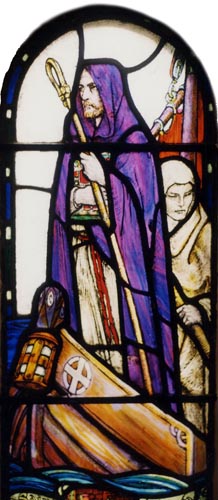|
|
|
 St.
Columba, Abbot of Iona St.
Columba, Abbot of Iona
(AD 521 - AD 597)
Columba, or Columcille,
was born on 7th December AD 521 in Gartan, near Lough Gartan in Co Donegal, the son of
Fedlimid of the Cenel Conaill, and his wife, Eithne. On his father's side, he was
great-great-grandson of Niall of the Nine Hostages, an Irish high-king in the
previous century. His birth name may have been Crimthann (meaning 'fox'),
but he was baptised Colum (meaning ‘dove’) at Temple-Douglas in Conwal by his
foster-uncle, St. Crunathan. The suffix ‘cille,’ meaning
‘of the church,’ was probably added to his name during his lifetime.
From a young age, Columba entered the monastic school at Movilla Abbey in
Newtownards, Co Down, under the direction of St. Finnian of Movilla. His master had studied at Whithorn Abbey in Galloway under St. Ninian.
Having completed his training and become a deacon, at the age of about twenty, Columba travelled southwards into Leinster.
He briefly became the pupil of an aged holy man named Gemman before entering Clonard Abbey in Co Meath, noted for its sanctity and learning
under St. Finnian of Clonard who had studied under St. Cadog at Llancarfan Abbey in South Wales. Columba became a monk there and eventually
was ordained a priest by Bishop Etchen. By this time, Columba was a striking figure, both
sturdy and tall, with a loud melodious voice that could be heard from one
hilltop to another. His next teacher was St. Mobhi at Glasnevin
Abbey in Co Dublin, but a pestilence that devastated Ireland in AD 544 caused his
disciples to disperse, and Columba returned to Ulster. There he founded his
first church in an old fort, on what is now the site of Derry Cathedral (Co
Londonderry). Subsequent prominent foundations included Durrow Abbey (Co Offaly) and the Abbey of Kells
(Co Meath). While in Derry, Columba is said to have planned a pilgrimage to
Rome and Jerusalem but, unfortunately, he did not make it passed Tours.
Around AD 561, Columba
apparently encouraged his countrymen to rise up in battle against the High-King of Ireland, Diarmait Mac Cerbaill, at
Cooldrevny (Co Sligo) in revenge for the monarch's violation of the right of
sanctuary. A synod of clerics sent Columba into exile in punishment for the many
deaths there and he resolved to expiate his offence by converting, to
Christianity, as many people as had died in the battle. So, in AD 563, he
travelled to Scotland with twelve companions in a leather-covered wicker
currach boat. He landed near Southend, on the Kintyre Peninsula, in the
Irish-settled Kingdom of Dalriada. His kinsman, King Conall mac Comgaill,
who had probably invited him to visit the area, gave him the island of Iona,
off Mull in the Inner Hebrides, upon which to found a monastery. From there, he became an
enthusiastic missionary, as well as a Royal diplomat. On a brief return
visit to his homeland in AD 575 to attend the Synod of Drumceat, High-King Aedh mac Ainmuirech of
Ireland was persuaded, through Columba’s influence, to renounce all rights
of sovereignty over British Dalriada. Back in Scotland, Columba visited
the pagan King Bridei of the Picts, at his base in Inverness and won his respect, but
not his conversion. Columba performed many miracles during
this missionary time, notably his famous encounter with the Loch Ness Monster. He became well-known across Scotland as a man of letters, writing
hymns, transcribing holy books and founding many churches throughout the
Hebrides and elsewhere. Under his guidance, Iona became a famous centre of literacy
and school for missionaries.
Columba died and was buried on Iona on 9th June AD 597. Half of his relics
were eventually sent to Ireland in AD 849.
|
 |